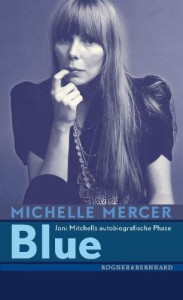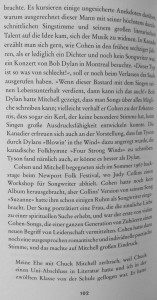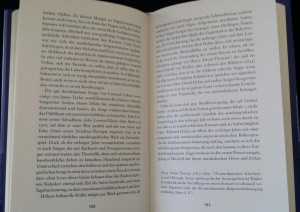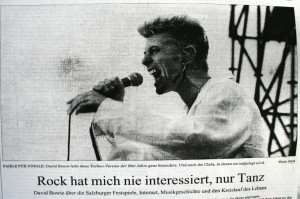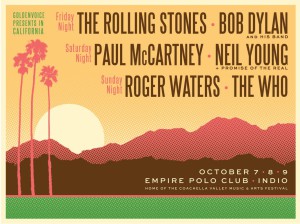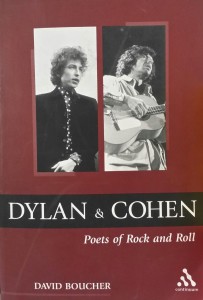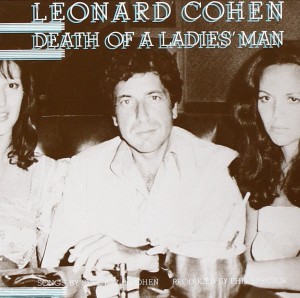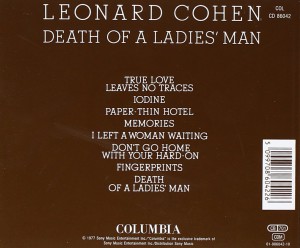In ihrer bereits 2009 erschiene nen Biographie „Blue“ erinnert sich die kanadische Singer/ Songwriterin Joni Mitchell nicht nur gerne an ihr Verhältnis zu Leonard Cohen, sondern erzählt auch über Einflüsse von Cohen und Dylan auf ihr eigenes Werk.
Archiv für den Monat: Mai 2016
KW-17-2016: 75 JAHRE BOB DYLAN – 75 Beiträge zu Dylans 75. Geburtstag – (13/75 – DAVID BOWIE ON BOB DYLAN `n `LEONARD COHEN: COHEN & DYLAN – Performances, in Concert, Music & Poetry, Anecdotes & Infos. the neverending & everlasting comparison. COHEN & DYLAN – Some critical analysises – by Christof Graf
Foto: David Bowie by Christof Graf
…. This is an ode to the folk singer, Bob Dylan. It includes the lyric: „Now hear this Robert Zimmerman, though I don’t suppose we’ll meet.“ Funnily enough, Bowie would go on to meet Dylan multiple times throughout the 70s and 80s, though Dylan was reportedly rude to Bowie and according to one biographer, Dylan told Bowie that he hated his Young Americans album!
###
Nevertheless, David Bowie called Bob Dylan and Leonard Cohen as two among 29 musicians, he was inspired by.
###
In einem PLAYBOW-Interview aus dem Jahre 1976 erzählte Bowie:
PLAYBOY: You’re not noted for cordial relationships with other artists. Yet there was the rumor that you flew to Europe to spend a sabbatical with Bob Dylan. What about it?
BOWIE: That’s a beaut. I haven’t even left this bloody country in years. I saw Dylan in New York seven, eight months ago. We don’t have a lot to talk about. We’re not great friends. Actually, I think he hates me.
PLAYBOY: Under what circumstances did you meet?
BOWIE: Very bad ones. We went back to somebody’s house after some gig at a club. We had all gone to see someone. I can’t remember who, and Dylan was there. I was in a very, sort of…verbose frame of mind. And I just talked at him for hours and hours and hours, and whether I amused him or scared him or repulsed him, I really don’t know. I didn’t wait for any answers. I just went on and on about everything. And then I said goodnight. He never phoned me.
###
20 Jahre später gab Bowie im Hamburger Atlantic-Hotel ein Interview anlässlich des „Earthling-Albums“, in dem der Interviewer auch auf Dylan zu sprechen kam. Es war kurz nach der Meldung, Dylan hätte ernsthafte gesundheitliche Probleme:
… [interrupts] out of the hospital. Someone told me the breaking news just minutes ago. I have to admit I was nervous about his recent state of health. But everything should be OK by now.
You are a man who has continued to rediscover himself and his music. In this sense you are similar to Bob Dylan.
His comeback since the beginning of the nineties is simply spectacular and this positive tendency will continue, of this I am quite sure. His albums have a great class to them, even those albums where he is actually playing songs of long-dead blues singers. His writing, his song texts, leave me speechless. To a certain extent it’s a disadvantage for him that in certain circles today it’s not exactly fashionable to listen to Bob Dylan.
Do you really think that something like that bothers someone like Dylan?
No, I don’t think so. I am actually pretty sure that he is totally immersed in what he does. I mean, if he writes, then he writes. That means that when he writes, he writes for himself. And not for anyone else. I’ve also experienced that if you have an audience, then you have an audience. If you don’t have one, then you don’t have one. But when you have a task, a goal, something that you can lose yourself in, then you just do it. Then one isn’t really interested in being popular with one’s audience. Dylan is a writer in the original sense of the word: you write, but you’re not a supplier for consumers. Period. End.
###
im Verlaufe des Interviews wird nochmals auf Dylan eingegangen:
If we can come back to Bob Dylan once more, his texts and his music, indeed his entire presence, has become more serious or one could even say more religious or more spiritual, without having needed to produce explicitly religious albums…
You’re right there, even if Bob Dylan has always had a very strongly developed sense for the metaphysical. I am furthermore of the opinion that he has from the very beginning been on a spiritual search that has consumed his entire energy and given his whole being and his work such a philosophical dimension. I can only too well understand that throughout this search he has encountered different religious structures that he has absorbed into himself and which have at different times flowed into his work. One of the forces that have always driven me both as an artist and as a private person has been the search for a reason—a rational, comprehensible reason for my existence. That is an intensely deep type of quest that forcibly leads one into a religious-spiritual examination of oneself. What I actually want to say is the following: if one sees this spiritual search for meaning as one’s mission in life, as Bob Dylan does, then it can turn into an obsession that, on the other hand, might take away the innocence one had before when one led a more unassuming, naïve and unburdened life. In other words, one perhaps isn’t as influenced by television and other fast moving things as one was previously. These are the important questions. That’s exactly how I see things as well and I’d like to emphasise that. I find much more pleasure in this self-examination than I do in other things.
The reason that I persist is that I have the feeling that there are a large number of similarities between yourself and Bob Dylan and that there is possibly some kind of even deeper level of respect between you two than is usually the case. Both of you have enriched musical history in several genres. Not very many musicians have so much creative drive! Another similarity between you and Dylan is that you are both very popular. A great deal of people would recognise you or Bob Dylan on the street. That surely has an effect, or not really?
You’re totally right, but there is a third similarity between us both: we actually have never sold that many records. For both of us it is the case that our work, our songs, are much more well known than would be usual relative to the number of recordings we have sold. I find that strange and noteworthy at the same time. We have both written songs that are extremely well known around the world, but hardly anyone has them on record at home. That is really unusual. That might be because we have both been far more occupied in our lives with changing things, exploring the textures of music and finding out exactly what music is capable of doing rather than simply writing songs and then sitting back comfortably and attaching ourselves to this or that trend. I’d go so far as to say that our task was and still is to explore the depths of music and to alter the shape of music. Bob Dylan has said about himself that he “was chosen to be a performer”. I think that says everything. We have changed and expanded the vocabulary of music and we have thrown new facets into the great big pot of musical history. And the songs we have written can be considered as the proverbial splinters that fall when wood must be chopped. I suspect that the majority of people out there would also see it that way: they have watched on with interest at our experiments but have preferred to buy the songs of other artists who have set about turning the results of our research into more refined forms.
In this way you are characterizing your songs and the songs of Bob Dylan as a kind of common property?
Yes, it appears that way to me. Having said that, it fills me with a sheer unfathomable happiness that it is that way. I am not complaining. I have a great sense of joy for example when I see or hear bands out there and I notice that they consciously or unconsciously are adapting things that I was the first to do so many years ago. That’s when one has the sweet realisation that one has changed music. That is immensely satisfying, having such a feeling. That all being well, this feeling of happiness hasn’t helped me in the slightest to answer the questions that I carry around with me. I sometimes get the impression that in this regard I haven’t taken a step forward since I was 19.
Quelle:
http://www.electronicbeats.net/from-the-vaults-david-bowie-i-am-he-who-quotes-i-am-the-sponge-that-absorbs/
Über Cohen liess sich Bowie nie derart speziell aus, In einem Interview aus dem Jahre 1996 anlässlich des Bizarre-Festival in Offenbach mit mir nannte er ihn zumindest als „erinflussreicher Songwriter“ unserer Zeit“., neben Bob Dylan.
KW-17-2016: 75 JAHRE BOB DYLAN – 75 Beiträge zu Dylans 75. Geburtstag – (12/75 – Matisse, Kafka und Bracque – Various Positions by JOhn Illsley. Der Ex-Dire-Straits-Mitbegründer über Dylan & Cohen: COHEN & DYLAN – Performances, in Concert, Music & Poetry, Anecdotes & Infos. the neverending & everlasting comparison. COHEN & DYLAN – Some critical analysises – by Christof Graf
KW-17-2016: 75 JAHRE BOB DYLAN – 75 Beiträge zu Dylans 75. Geburtstag – (11/75 – Bob Dylan`s Japan Tour 2016 ist zu Ende – Cohen gab in Japan nie Konzerte: COHEN & DYLAN – Performances, in Concert, Music & Poetry, Anecdotes & Infos. the neverending & everlasting comparison. COHEN & DYLAN – Some critical analysises – by Christof Graf
Dylan begannt 1978 in Japan zu touren. Cohen trat dort nie auf.
Am 28. April endete Dylans jüngste Japan Tour mit fast der gleichen Setlist wie im vergangenen Jahr….
voila
| Yokohama, Japan Pacifico April 28, 2016 |
| 1. | Things Have Changed (Bob center stage) |
| 2. | She Belongs To Me (Bob center stage with harp) |
| 3. | Beyond Here Lies Nothin‘ (Bob on piano) |
| 4. | What’ll I Do (Bob center stage) |
| 5. | Duquesne Whistle (Bob on piano) |
| 6. | Melancholy Mood (Bob center stage) |
| 7. | Pay In Blood (Bob center stage) |
| 8. | I’m A Fool To Want You (Bob center stage) |
| 9. | That Old Black Magic (Bob center stage) |
| 10. | Tangled Up In Blue (Bob center stage with harp then on piano) |
| (intermission) | |
| 11. | High Water (For Charley Patton) (Bob center stage) |
| 12. | Why Try To Change Me Now (Bob center stage) |
| 13. | Early Roman Kings (Bob on piano) |
| 14. | The Night We Called It A Day (Bob center stage) |
| 15. | Spirit On The Water (Bob on piano) |
| 16. | Scarlet Town (Bob center stage) |
| 17. | All Or Nothing At All (Bob center stage) |
| 18. | Long And Wasted Years (Bob center stage) |
| 19. | Autumn Leaves (Bob center stage) |
| (encore) | |
| 20. | Blowin‘ In The Wind (Bob on piano, Donnie on violin) |
| 21. | Love Sick (Bob center stage) |
KW-17-2016: 75 JAHRE BOB DYLAN – 75 Beiträge zu Dylans 75. Geburtstag – (10/75 – . Der Desert-Trip in die kalifornische Wüste. Bob Dylan`s verspätete Geburtstagsparty: COHEN & DYLAN – Performances, in Concert, Music & Poetry, Anecdotes & Infos. the neverending & everlasting comparison. COHEN & DYLAN – Some critical analysises – by Christof Graf
Ein solches Festivalplakate & Line JUp hat es seit den 70ern schon nicht mehr gegeben. The Who neben den Stones, Neil Young und Bob Dylan (Obacht, das gab es auch in den 90ern). Dazu noch Ex.Beatle Paul Mc Cartney und Ex-Pink Floyd Roger Waters. Eine kleine Sensation ist perfekt. Und mittendrin das Geburtstagskind vom Mai: Bob Dylan. Herrlisch. So „herrlisch“ sind auch die Preise.
Leonard Cohen ist nicht dabei. Die Gemeinsamkeit? Die Macher des Festivals sind dioe vom Coachella-Festival. Und dort trat Leonard Cohen schon einmal auf. Die Welt ist ahlt doch klein…
Three-day passes run from $399 to $1,599. Single-day tickets will go for $199. Tickets will go on sale Monday, May 9th at 10 am PST at the festival’s website.
More Infos: http://www.rollingstone.com/music/news/stones-mccartney-dylan-the-who-waters-young-confirm-mega-fest-20160503#ixzz47fffaJgL
Follow us: @rollingstone on Twitter | RollingStone on Facebook
KW-17-2016: 75 JAHRE BOB DYLAN – 75 Beiträge zu Dylans 75. Geburtstag – (9/75 – Poets Of Rock`n`Roll by David Boucher . Lesenswert: ein ganzes Buch über den Vergleich von Bob Dylan & Leonard Cohen: COHEN & DYLAN – Performances, in Concert, Music & Poetry, Anecdotes & Infos. the neverending & everlasting comparison. COHEN & DYLAN – Some critical analysises – by Christof Graf
About the book
Bob Dylan and Leonard Cohen are widely acknowledged as the great pop poets of the 1960s, transforming the popular song into a medium for questionng the personal, social, and political norms of their times. They emerged at a time when the music industry was transforming the revolutionary sound of black music into something bland, homogenous, and fit for mass consumption. For many members of their generation, Dylan and Cohen were able to articulate what they were feeling and could not express: anti-establishement anger, angst, and despondency.
Dylan and Cohen is a fascinating political, psychological and artistic profile of these two iconic writers and performers. With reference to both biographical details and lyrics. David Boucher explores their similarities and differences, tracing the development of religious political, and social themes in their work and the ways in which those ideas engaged a new audience.
A must-read for all serious fans of either Dylan or Cohen, this book will also engage anyone interested in the North America of the 1960s, or more generally in the relationship between music, identity and politics.
Pressestimmen
Reviewed in Record Collector (UK) February 2005 issue by Patrick Humphries–Patrick Humphries
.If you think it s only right and proper that our finest songwriters are treated with the same academic respect as Shakespeare and Milton, then you re in for a fascinating read. Uncut, September 2004
Those researching the course of modern culture will no doubt find the heavily annotated work of use. Kerry Dexter, Dirty Linen #114, October / November 2004
Synopsis
Bob Dylan and Leonard Cohen are widely acknowledged as the great pop poets of the 1960s, transforming the popular song into a medium for questioning the personal, social and political norms of their times. They emerge at a time when the music industry was moulding and packaging the revolutionary sound of black music into something bland, homogenous and fit for mass consumption, when populist politics had come to the fore with a serious division emerging between the values of young and old. For many disorientated and disillusioned members of this generation, Dylan and Cohen were able to articulate what they were feeling and could not express: Dylan the anti-establishment anger, Cohen the angst and despondency. Dylan and Cohen is a fascinating political, psychological and artistic profile of two iconic writers and performers. With reference to both biographical details and lyrics, David Boucher explores their similarities and differences, tracing the development of religious, political and social themes in their work and the ways in which those ideas engaged a new audience.
He also looks at their poetic influences, using aesthetic ideas from Lorca, Collingwood and others to delve more deeply than previous commentators into the phases of their writing and to reveal their enduring influence on poetry and song, and the relationship between the two. A must-read for all serious fans of either Dylan or Cohen, this book will also engage anyone interested in 1960s America or more generally in the relationship between music, identity and politics.
KW-17-2016: 75 JAHRE BOB DYLAN – 75 Beiträge zu Dylans 75. Geburtstag – (8/75 – Bob Dylan singt auf Leonard Cohen`s Album „Death Of A Lady`s Man“ : COHEN & DYLAN – Performances, in Concert, Music & Poetry, Anecdotes & Infos. the neverending & everlasting comparison. COHEN & DYLAN – Some critical analysises – by Christof Graf
„Death Of A Ladie`s Man“, das „dazugehörige“ Buch heisst dagegen „Death Of A Lady`s Man“ ist das wohl umstrittenste Album von Leonard Cohen. Für die einen stellt das Album das schlichte ,,Genie“, für andere den puren ,,Wahnsinn“ dar. Für die einen ist es Cohens bestes, für andere Cohens schlechtestes Album. Ein Dazwischen gibt es nichts. ,,Ich kann beide Positionen nachvollziehen“, bekennt Cohen. Während das vorherige Album geradezu gefällig wirkte, wird ,,Death Of A Ladie`s Man“ gerne auch als schwer zugänglich beschrieben. Schuld daran ist nicht Cohens nach wie vor vorhandene lyrische Tiefe, Schuld ist eher der durch Produzenten-Legende Phil Spector entstandene musikalische Bombast.
Unter den Namen der an den Background Vocals beteiligten Künstlern findet sich auch der von Bob Dylan. Er „schneite“ ebenso wie Alan Ginsberg einfach mal im Studio vorbei und beteiligte sich bei den Chorgesängen…
Bob Dylan singt also auf einem Album von Leonard Cohen. Leonard Cohen sang dagegen nie auch einem Album von Bob Dylan.
KW-17-2016: 75 JAHRE BOB DYLAN – 75 Beiträge zu Dylans 75. Geburtstag – (7/75 – Bob Dylan`s E-Mail Message to the PEN AWARD: Leonard Cohen is the KAFKA OF THE BLUES : COHEN & DYLAN – Performances, in Concert, Music & Poetry, Anecdotes & Infos. the neverending & everlasting comparison. COHEN & DYLAN – Some critical analysises – by Christof Graf
Als Keith Richards, Chuck Berry und Leonard Cohen mit dem PEN Award gekürt wurde, lies es sich Bob Dylan nicht nehmen, den drei mit einer E-Mail-Message seinen Tribut zu zollen. In der Mail war Folgendes zu lesen:
„To Chuck, the Shakespeare of rock and roll, congratulations on your PEN award, that’s what too much monkey business will get ya . . . Say hello to Mr. Leonard, Kafka of the blues, and Lord Byron Keith (Richards) if he shows up. In all seriousness, Chuck, congratulations on this prestigious honor. You have indeed written the book with a capital B, and congratulations to Leonard, who’s still writing it – Bob Dylan“
KW-17-2016: 75 JAHRE BOB DYLAN – 75 Beiträge zu Dylans 75. Geburtstag – (6/75 – Dylan & Picasso, Cohen & Matisse : COHEN & DYLAN – Performances, in Concert, Music & Poetry, Anecdotes & Infos. the neverending & everlasting comparison. COHEN & DYLAN – Some critical analysises – by Christof Graf
Dylan & Picasso, Cohen & Matisse
Zu Bob Dylan fühlte sich Cohen hingezogen, seit er dessen Platten Mitte der 60er Jahre zum ersten Mal hörte. Cohen bemerkte 1967 gar einmal, daß er „so etwas wie der Spiegel Bob Dylans“ sei, und selber am meisten davon beeindruckt wie auch überrascht wäre, weil ihm manches von Dylan sehr bekannt vorkäme.
Er sei wie eine Figur aus einem seiner Bücher, die lebendig geworden wäre. Irgendwie hätte er das Gefühl gehabt, als ob er ihn „erfunden“ hätte. „Als ich ihn das erste Mal gehört habe, habe ich ihn sofort verstanden. Ich habe verstanden, was er tat. Ich sah, daß er eine Rolle einnahm, in der ich mich gerne gesehen hätte. Ich habe mich ermutigt gefühlt, als ich seine Musik hörte. Denn wenn man Dylans Musik zuhört, hat man das Gefühl, neue vielleicht nicht gekannte Energien freigesetzt zu bekommen. Das macht den Wert eines künstlerischen Werkes überhaupt aus.“
Eine ähnliche Sichtweise ergab sich auch bei einem Gespräch zwischen dem Autor und Paul Williams, bei Dylans Konzert in Prag 1995: „Erst, wenn man auf dem Weg ist, das Konzerterlebnis als ein Stück Kunst zu erfahren, ist man auf dem Weg zu verstehen, daß mit dem Konzert – unabhängig von der Tonaufnahme – der eigentliche Akt des Kunstschaffens stattfindet.“ Künstler wie Dylan oder auch Cohen schaffen mit jedem Auftritt Kunst und vergrößern damit ihr künstlerisches Werk. Cohen verglich Dylan 1988 in einem Interview mit dem MUSICIAN MAGAZINE gar mit Pablo Picasso: „Nobody is identifying our populär singers like Matisse or Picasso. Dylan’s a Picasso that exuberance ränge and assimilation of the whole history of music.“
In einem anderen Interview mit dem Autor bemerkte Cohen auf die Frage, mit wem er dann zu vergleichen sei, wenn Dylans malerisches Pendant Picasso sei: „Natürlich Matisse“. Der Vergleich Dylans mit Picasso ist in der Tat legitim. Gerade wenn man das Dylan’sche Wortgut der 60er Jahre untersucht, läßt sich die Nähe Dylans zum Surrealismus nicht leugnen. Hält man sich an die Definition des Surrealismus, als psychischem Automatismus, ist die Untersuchung dieser Analogie interessant. In frühen Dylan-Songs wie z.B. „Farewell Angelina“ oder in „Visions Of Johanna“ sind ähnlich bizarre und skurille Bilder zu erkennen, wie sie Picasso mit Zeichenstift und Pinsel schuf. Ein weiterer Ansatzpunkt ist seine von Picasso bekannte Produktivität. Ähnlich wie der unentwegt kreative Picasso, der selbst nebenbei ständig zumindest irgendetwas skizzierte, malte er fast täglich oder war stets anderweitig künstlerisch tätig. Er arbeitete, weil sein Inneres aus ihm heraus mußte. Dies ist die Motivation des Handelns. Er hat keine andere Wahl, als seine Kreativität herauszulassen. Zudem ist beiden Künstlern wohl auch der Wesenszug des Egozentrikers gemein.
Die jeweiligen Biographien spiegeln sich in den Werken der Künstler wieder. Neue Welten werden erschlossen. Beide Künstler haben einen großen Fundus unveröffentlichter Werke. Beide arbeiten bzw. arbeiteten an bereits bestehenden Werken immer wieder von Neuem und schufen mit dieser Bearbeitung auch wieder neue Werke. In diesem Zusammenhang ist darauf hinzuweisen, daß gerade bei dieser von Picasso bekannten Methodik das alte, vom Betrachter eigentlich schon für perfekt gehaltene Werk in dem Pro-zeß der Bearbeitung und des Neuschaffens völlig zerstört wird. Statt dessen entsteht unter den Händen Picassos ein höher stilisiertes, abstraktes, entfremdetes Werk, dem der in diesen Dingen (scheinbar) naive Betrachter zuerst einmal den Untergang des vorhergehenden, weniger abstrakten und dafür greifbareren vertrauteren Werkes vorwirft. Gerade an dieser Visualisie-rung des Prozesses der Neuschaffung durch Destruktion des ursprünglichen
Werkes wird die Parallele zu Dylan sichtbar und gerade diese Analogie führt zum Verständnis des Gesamtwerkes von Bob Dylan in den 12 Jahren, die die Never Ending Tour umspannen. „Tangled Up In Blue“ ist ein solches Beispiel. Der Song wurde 1974 geschrieben und 1975 veröffentlicht. 1978 und 1984 änderte Dylan den Text und präsentierte erst 1988 den Song wieder in der UrFassung. Auch Cohen weiß seine Werke im Laufe der Zeit zu variieren, was z.B. die beiden Fassungen des Song „Chelsea Hotel #1″ und „#2″ mit unterschiedlichen Strophen beweisen.
Auch der Song „Democracy“ unterliegt live einer Wandlung. Bei seiner’93er „Future“-World Tour offerierte Cohen mehr als die sechs vom Album bekannten Strophen. Das Script hat 80 Strophen. Doch Cohen ist mehr als Dylan der totale Formalist. Nach außen verkörpert er die Suche nach Perfektion, im Innern praktiziert er das totale Streben nach Freiheit.
Ähnlich wie z.B. Matisse präferiert Cohen diese extreme Form der kultivierten Lebensart, woraus er seine Methode entwickelt. Mit dem totalen Formalismus die totale Freiheit anzustreben, um so zu einem wahren Wilden zu werden, ist sein Ziel. Seine Art des gentlemanliken Auftretens und die Form seiner Kunst unterstützt den Vergleich mit Matisse. In dem Gewand der Bourgeoisie agiert er als Enfant Terrible. Im Erreichen der totalen Kontrolle über sich gelangt er zu Bildern, die ohne diese vorherige Kontrolle, nie unkontrolliert wirken könnten. Wenn Cohen Abend für Abend dieselbe Geschichte erzählt, scheint es, als ob er seine Spontanität hinter einem durchdachten Konstrukt verbirgt, womit sich der Kreis der Analogien, Dylan und Picasso, Cohen und Matisse schließt.
KW-17-2016: 75 JAHRE BOB DYLAN – 75 Beiträge zu Dylans 75. Geburtstag – (5/75 – one of those anecdotes: dylan & cohen in paris oder: „Ich und Ich und Hallelujah“ : COHEN & DYLAN – Performances, in Concert, Music & Poetry, Anecdotes & Infos. the neverending & everlasting comparison. COHEN & DYLAN – Some critical anaylises – by Christof Graf
Über die Entstehungsgeschichte von Songs unterhielten sich Dylan und Cohen eines Tages in Paris Ende der 80er. Die Geschichte ist heute Legende…
„Vor einigen Jahren war ich bei einem Bob Dylan-Konzert in Paris“, erinnerte sich Cohen: „Und hinterher sind wir einen Kaffee trinken gegangen. Er fragte mich, wieviel Zeit ich gebraucht hätte, um das Lied „Hallelujah“ zu schreiben, das er im Konzert gespielt hatte. „Tja… ich weiß nicht, sagte ich,… vielleicht zwei Jahre. Dann fragte ich ihn, wie lange er für das Stück „l And l“ gebraucht hätte, und er antworte: Eine Viertelstunde.“

